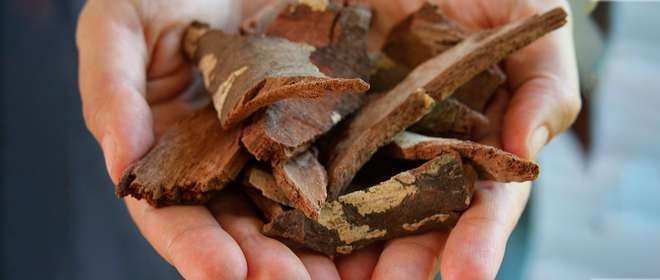- We make discreet and personalized shipments to the client's taste!

Chuchuwasi: Discover its Secrets and Traditional Uses in Detail
CHUCHUWASI
With the scientific name Maytenus macrocarpa (R. & P.) Briq. and belonging to the botanical family Celastraceae, Chuchuwasi is revealed as an Amazonian master plant with extraordinary properties. This article explores its traditional uses in depth, highlighting its applications and benefits.n aphrodisiac, analgesic, antidiarrheal, anti-dysentery, anti-inflammatory, intestinal parasite (helminth), anti-pyretic, arthritis, against bronchitis, for dysmenorrhea, back and muscle pain, as a stimulant, for hemorrhoids, for impotence, for kidney inflammation, as an Immune system stimulant, in menstrual irregularities, as a tonic and muscle relaxant, for colds, rheumatism, as a sedative, in gastrointestinal disorders, for the treatment of nipple fissures, tuberculosis, for tumors, and ulcers.
Chuchuwasi: One Plant, Countless Traditional Uses
Since ancient times, Chuchuwasi has been a fundamental piece in traditional Amazonian medicine. Its uses cover a wide range of conditions, offering natural solutions for various ailments.
Aphrodisiac and Treatment for Arthritis
Traditional Use:
Chuchuwasi has been recognized for its aphrodisiac properties and its ability to relieve the symptoms of arthritis. The preparation involves marinating 50 grams of roots with 200 milliliters of honey in a liter of alcohol at 70° for eight days.
Administration and Dosage:
Administration is oral, taking one glass a day for a month. For those seeking relief from arthritis, it is recommended to rest and avoid physical exertion that could worsen the situation.
Recommendations and Conservation:
A diet that excludes frozen and alcoholic drinks is recommended, and storage in a dry glass container, in a cool, shady place and out of the reach of children.
As a Painkiller
Traditional Use:
Chuchuwasi is also used as an analgesic, relieving pain in affected areas. The preparation consists of marinating 50 grams of root in a liter of alcohol at 70°.
Administration and Dosage:
Administration is oral, taking a drink every morning for a week.
Recommendations and Conservation:
Avoid chili, coffee and liquor during treatment. Furthermore, it is advisable not to bathe in the river or get wet with rainwater. Resting is essential. Conservation is carried out in a clean and dry glass container, in a cool and shady place.
Against Rheumatism: Specific Treatment
Traditional Use:
Chuchuwasi is used to relieve pain and inflammation of the joints, muscles and tendons in cases of rheumatism.
Preparation and Administration:
Crumble 250 grams of dried roots in a bottle with rum, brandy or 70-80% ethyl alcohol; seal for seven days for better maceration.
Dosage and Diet:
Take a cup (60 to 75 milliliters) of the preparation on an empty stomach in the morning. The diet during treatment includes energy saving, rest and avoiding getting wet with rainwater, no sexual activity and excluding pork, spices, alcohol, tobacco and chili.
Recommendations and Conservation:
It is recommended to be taken after meals in cases of gastritis and is not suitable for pregnant women or children under fifteen years of age. Do not exceed the suggested dose and avoid prolonged use to prevent gastric irritation. Conservation is carried out at room temperature in the shade in a hermetically closed glass container.
Chemical Composition of Chuchuwasi
Chuchuwasi reveals its richness through its chemical composition, which includes sesquiterpene alkaloids, antioxidants, canophyllol, catechins, polyol esters, phenoldienones, phenoldiones, flavonols, Friedelina, laevisin A and B, macrocarpine A, B, C and D, maitein, maitenin, maytansin, maitensin, mebeverine, nocotinil, pristimeran, proanthocyanidins A and B, sesquiterpenes, tannins and tingenone triterpenes (damarana triterpenes, Friedelana triterpenes).
Conclusion: Chuchuwasi, a Treasure of Nature
Chuchuwasi stands as a treasure of nature, offering natural solutions for various conditions. This article has explored its traditional uses, preparations, administration and conservation, providing a complete guide for those interested in discovering the secrets of this Amazonian master plant.
Frequently Asked Questions (FAQs)
Where can I find authentic Chuchuwasi for purchase?
We recommend looking in stores specializing in natural products or trusted herbalists.
What is the recommended daily dose of Chuchuwasi to take advantage of its benefits?
The dosage may vary depending on the purpose, but it is always advisable to follow traditional instructions and consult a health professional.
Are there any known side effects when using Chuchuwasi?
Chuchuwasi is generally considered safe when used as directed. However, it is important to be aware of any adverse reactions and seek medical advice if necessary.
Can Chuchuwasi be used as part of a daily wellness routine?
Yes, as long as traditional guidelines are followed and the diet is adjusted as directed to maximize benefits.
How long does the preparation of Chuchuwasi take and what is its shelf life?
The preparation lasts approximately eight days, and it is recommended to follow the conservation guidelines to ensure its effectiveness over time.



